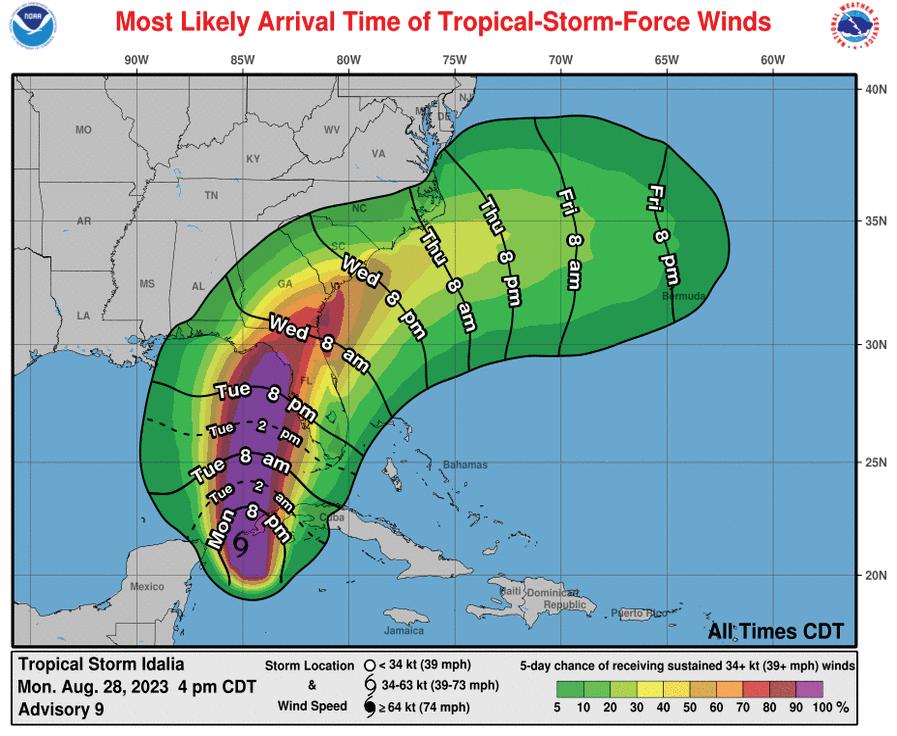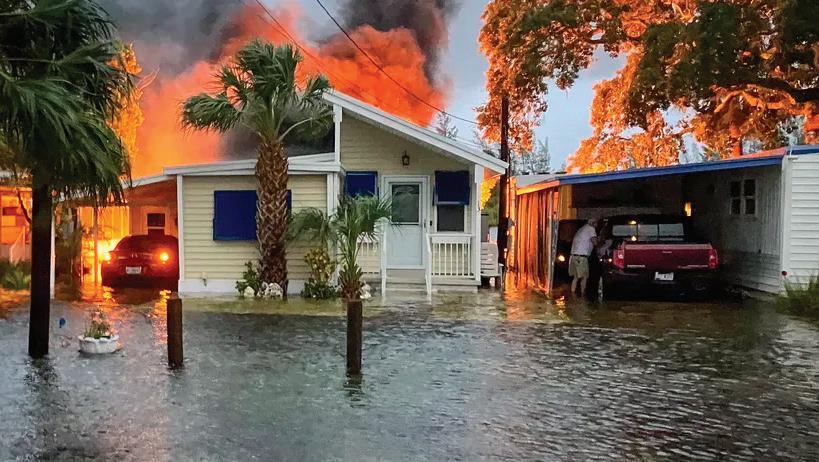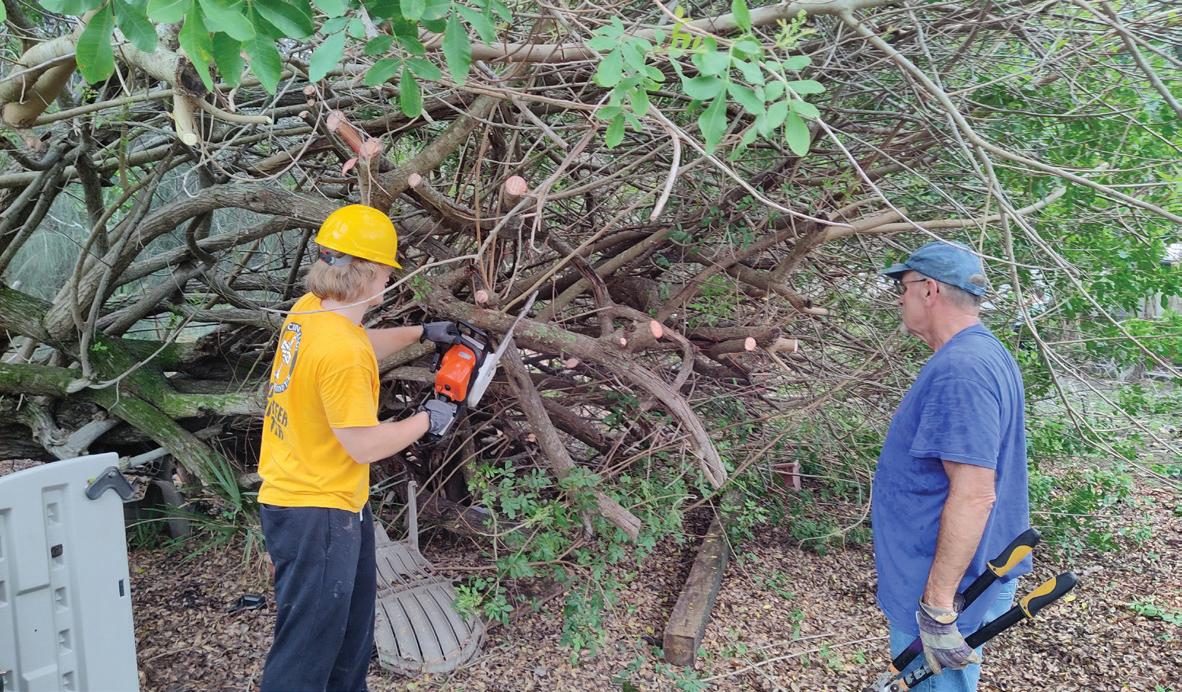PINELLAS COUNTY HURRICANE GUIDE
• Storm impacts extend far beyond the forecast cone you see on the news or social media.
• Hurricane Idalia flooded more than 1,500 homes in Pinellas County in 2023.
• The center of the storm was 100 miles offshore.


• Storm impacts extend far beyond the forecast cone you see on the news or social media.
• Hurricane Idalia flooded more than 1,500 homes in Pinellas County in 2023.
• The center of the storm was 100 miles offshore.



Once a storm is threatening Pinellas County, there will be a limited amount of time for you to get ready, get set and protect yourself from the impacts. This guide will help you determine your risk and know what to do and what to expect.
Know your risks.
Storm impacts can extend far outside of the forecast cone. Know what actions to take based on your risks.

Page 3 ................................ Storm surge
Page 4 ............................................ Wind
Page 5 ........................................... Flood
Page 6 ...........................What you need
Page 7 ......................... Who to plan for
Page 8 ...................... Where to get info
Page 9 .................................. Stay or go?
Time to take action.
As the storm moves closer and Pinellas County is forecast to have impacts, it is time to get set. Evacuation orders could range from 17-50 hours before impact.

Page 10 .....................Picture the threat
Page 11 ................. Get out of the zone
Page 12 ....................
Know when to go
Page 13 ....................Secure your home
Page 14 .................. Evacuation options
Page 15 .........................Shelter options
Stay safe.
As conditions become unsafe, you will need to shelter in place. It is not safe to move around during or immediately after a storm.

Page 16 ........................ Shelter in place
Page 17 .....................................Outages
Page 18 ........................ After the storm
Page 19 ...................... Recovery begins
Page 20 ........ Pinellas County contacts

Storm surge in Lee County during Hurricane Ian in 2022. Courtesy of Max Olson Chasing
Storm surge is the wall of water that a hurricane pushes onto land.
• It can range from a few feet to over 26 feet.
• It impacts coastal areas first, then moves farther inland.
• It is fast-moving and fast-rising.
• It can wash away buildings and roads.
• Surge is life-threatening.

Evacuation zones are based on storm surge risk. This map shows the areas where storm surge could occur. See more about storm surge, page 10.
There are several ways to find out your evacuation zone:
• disaster.pinellas.gov
•

You need to be out of the evacuation areas before winds and/or storm surge arrive.




Winds in a hurricane can extend out for hundreds of miles beyond the center.
Winds can range from gusts to continuous hurricane-force speeds.
Tornadoes can occur during hurricanes.
Winds can last from a few hours to more than 24 hours.

Stay informed and know when dangerous winds will arrive.
• Evacuation might take more time than usual.
If you are on life-sustaining medical equipment
• Make a plan to shelter in a location with a backup generator.
• See special needs, page 7.

This advisory from the National Hurricane Center (NHC), issued as Hurricane Idalia approached Florida, shows the most likely arrival of tropical storm-force winds, which affected the entire state. Timing may change with every advisory issued (every six hours).
Know if your home is strong enough to stay in. Consider:
• The year it was built.
• The materials it was built with.
• The year the roof was replaced.
• Whether you have hurricane-impact windows and/or coverings for windows and doors.
• Buses used for evacuations will stop running several hours before dangerous winds start.
• Emergency response vehicles will stop running when conditions are no longer safe due to wind.
Watch videos on how you can protect your home at flash.org/peril/hurricane.

See details about your property on the Pinellas County Property Appraiser website at pcpao.gov.

Hurricane-force winds could damage roofs, unprotected windows and doors. Follow the QR code to see an animation.
Mobile and manufactured homes are very vulnerable to strong winds. Source:





A lot of rain can fall in a short amount of time.
• This causes flooding in roads.
• You may not be able to leave your home.
• Floodwater may enter your home.
• Responders may not be able to help you.
Have a plan to protect the items in your home.
• Elevate valuables and furniture in your home.
• Place important documents in waterproof containers.
• Move your car to higher ground.
• Before a storm, check storm drains near your home and remove any loose leaves or items that may block drainage.
• Sandbags or other flood barriers may help keep some water out of your home, but not large amounts of rain and storm surge. If flooding is expected, sandbags may be offered. Check with your city.
Unincorporated Pinellas County can check the website pinellas.gov/sandbags.



How strong is water? How much does it weigh? What is the effect of water on stationary objects: trees, cars, buildings? Research this topic in the Tampa Bay Times and on the following websites: pinellas.gov/flood, flash.org, nhc.noaa.gov and weather.gov. Create a blog post with the information you have learned from the video at oceantoday.noaa.gov/hurricanestormsurge. Florida Standards: SC.6.E.6.2; SC.6.E.7.2; SC.6.E.7.7; SC.6.E.7.8; SC.68.N.1.1; ELA.68.EE.1; ELA.68.EE.2; ELA.68.EE.3; ELA.68.EE.4; ELA.68.R.2.1; ELA.68.R.2.2; ELA.68.R.2.4; ELA.68.C.1.3; ELA.68.C.1.4; ELA.68.C.2.1; ELA.68.C.3.1; ELA.68.C.4.1; ELA.68.C.5.1; ELA.68.F.1.3; ELA.68.F.1.4; ELA.68.V.1.1; ELA.68.V.1.3
When a hurricane slams our coast, it’s important to be aware of all the dangers. As a reminder, emergency managers want us to run from the water and hide from the wind. What does this phrase mean? What are the risks from water? What are the risks from wind? Research these two phenomena and create a Venn diagram or chart comparing the risks: differences and similarities. Next, look for photos in the Tampa Bay Times and in this publication to create an infographic depicting this comparison. Share what you have learned with your class.
Florida Standards: ELA.68.EE.1; ELA.68.EE.2; ELA.68.EE.3; ELA.68.EE.4;


❏ Water: One gallon per person per day, for at least seven days.
❏ Nonperishable food: at least a one-week supply.
❏ Non-electric can opener.
❏ Paper plates, plastic cups and utensils.
❏ Medications.
❏ Extra bottled oxygen if needed.
❏ First aid supplies.
❏ Wipes, hand sanitizer, soap, toilet paper, feminine supplies, diapers.
❏ Eyeglasses and extra contact lenses.
❏ Flashlight or lantern.
❏ Battery-operated or hand-crank radio.
❏ Extra batteries.
❏ Cellphone with charger, extra battery backup, solar charger.
❏ Cash, preferably small bills.
❏ Books, cards, board games.
❏ Paper and pencil.
❏ Whistle.
❏ Rain gear.
❏ Insect repellent.
❏ Sunscreen.
❏ Full tank of gas in vehicle.
❏ Repair kit for car tires.
❏ Extra gas cans.
❏ Driver’s license, passport, other ID cards.
❏ Proof of residency (a bill sent to your address).
❏ Social Security card.
❏ Birth certificate.
❏ Marriage license, wills, death certificates, military records and other hard-to-replace documentsnot copies.
❏ Insurance policies for home, health, flood, auto, renters.
❏ Important numbers and emergency contacts.
❏ Medical records from pharmacy, doctors, blood type, vaccinations.
❏ Household inventory.
❏ Emergency access permit for barrier island residents and businesses.
❏ Baby food.
❏ Formula.
❏ Sterilized bottles.
❏ Bottled water.
❏ Medications.
❏ Diapers.
❏ Wipes.
❏ Clothing.
❏ Thermometer.
❏ Pacifier.
❏ Blanket.
❏ Comfort items.
❏ Plastic trash bags for diapers.
❏ Pet food/water for two weeks.
❏ Collar and leash.
❏ Carrier or crate.
❏ Newspaper or other lining.
❏ Identification/updated microchip.
❏ County license.
❏ Immunization records.
❏ Photo.
❏ Medications.
❏ Toys/blanket.
❏ Cat litter, pan, scoop.
❏ Plastic waste bags.
❏ Disinfectant.
❏ Paper towels.
In addition to general supplies:
❏ Pillow and blankets.

❏ Titles to house, vehicles, boats.
❏ Account numbers for bank, credit cards, savings and investments.
❏ Air mattress, sleeping bag, floor mat.
❏ Change of clothing for several days.
❏ Other supplies needed by host home.
In addition to general supplies:
❏ Blanket, pillow, cot, folding chair or twin-size air mattress.
❏ Change of clothing for several days.
❏ Special dietary items (sugar-free, low sodium, gluten-free, vegetarian/ vegan, etc.) with can opener, if required. Basic food/water is provided.
❏ Wearable medical alert tag.
❏ Ear plugs.
❏ Eye mask/covering.
In addition to general supplies:
❏ Wheelchair, walker, cane, other medical equipment.
❏ Oxygen concentrator.
❏ Nebulizer.
❏ Written instructions or orders regarding your care.
❏ Caretaker’s supplies.
In addition to general supplies (if you shelter in place or for when you return home):
❏ Ice, coolers.
❏ Tarps with rope or elastic cord, sheets of plastic.
❏ Wrench, utility knife, hammer, nails.
❏ Duct tape.
❏ Dust mask.
❏ Portable toilet or large bucket with lid.
❏ Large garbage bags.
❏ Disinfectant.
❏ Unscented bleach with medicine dropper.
❏ Matches or lighter.
❏ Outdoor grill and extra propane or charcoal.
Residents of all ages who have medical needs or require transportation assistance may be eligible for the program. Some examples include:
• Requiring assistance with routine care and medications.
• Dependent on oxygen or electricity for medical equipment.
• Requiring assistance with walking or getting out of bed.
• Requiring transportation assistance.
There are multiple ways to register:
• Ask your home health care provider.
• Register online at pinellas.gov/SpecialNeeds.
• Request a form. Call Pinellas County Emergency Management at 727-464-3800.
Do not wait until an emergency to register for the program. You may not be picked up if you register too late.
Build an emergency kit. See what you need, page 6.

Look through the Tampa Bay Times for photos and images of hurricane supplies. Print or cut out the photos to create a poster. Label the images for different needs. Are there items and resources for people of all ages with special needs or disabilities? Share your poster and supply list with your classmates and family. If possible, hold a hurricane supply collection drive in your classroom or family. Include the different items people might need during a hurricane.
Florida Standards: SC.68.N.1.1; ELA.68.EE.1; ELA.68.EE.2; ELA.68.EE.3; ELA.68.EE.4; ELA.68.R.2.1; ELA.68.R.2.2; ELA.68.R.2.4; ELA.68.C.1.3; ELA. 68.C.1.4; ELA.68.C.2.1; ELA.68.C.3.1; ELA.68.C.4.1; ELA.68.C.5.1; ELA.68.F.1.3; ELA.68.F.1.4; ELA.68.V.1.1; ELA.68.V.1.3
• Make sure county license, vaccinations and microchip contact information are up to date.
• Build a pet emergency kit. See what you need, page 6.
• Pinellas County offers pet-friendly shelters for dogs and cats. See shelter options, page 15.
• Some hotels and other lodging are pet-friendly.
Service animals are welcome at all shelters.
• Pets are not allowed at special needs shelters.
• Make a plan for the care of your pet.
• Specify if you have a pet when you register.
• As a last resort, Pinellas County Animal Services will care for your cat or dog at a separate animal shelter during the storm.
• Pets with chronic medical conditions cannot be cared for at the animal shelter.



Staying informed will help you stay safe during a disaster.
Free emergency notification system. Get alerts via text, phone and/or emails. Sign up at pinellas.gov/ AlertPinellas



Personalize emergency plans, use checklists, save insurance information, contacts, create an inventory and more. Emergency notifications will be sent to your phone when possible. This app is also offered in Spanish.


disaster.pinellas.gov
Basic information to prepare, up-to-theminute updates during emergencies, and information after the emergency.

• Facebook: facebook.com/PinellasGov
• X (formerly Twitter): @PinellasGov and @PinellasEM
• YouTube: @PinellasGov
• Get automatic alerts from the National Weather Service (NWS).
• Configure the radio to receive Pinellas County alerts only by using the Specific Area Message Encoding (SAME). The SAME code for Pinellas County is 012103.
• If the radio does not require a SAME, then tune to frequency 162.450. Tune into an available radio station Local stations include:
~ WUSF 89.7 FM (Public Radio)
~ WMNF 88.5 FM (Community Radio)
~ WFLA 970 AM (News)
~ Maxima 92.5 FM (Spanish)
~ Rumba 100.3 FM (Spanish)
• County Information Center 727-464-4333
Opens during emergencies. Hours vary and will be announced via the website, Ready Pinellas and social media.
• Live Chat: disaster.pinellas.gov This may be a more convenient option for those who are deaf or hard of hearing. Hours vary during a disaster.
Choose an action that a local, state or federal government agency does before or after a storm for the public. Identify the agency and department that does this work and describe why it is important. Identify who else they would need to coordinate with. Once you have the who, what, where, when, why and how questions answered, write an article for the Tampa Bay Times. Use the news articles in the Times as models. Share your article with your class.
Florida Standards: ELA.68.EE.1.1; ELA.68.EE.2.1; ELA.68.EE.4.1; ELA.68. EE.5.1; ELA.68.EE.6.1; ELA.68.F.2.1; ELA.68.C.1.3; ELA.68.C.1.4; ELA.68.C.1.5; ELA.68.C.2.1; ELA.68.C.3.1; ELA.68.C.4.1; ELA.68.R.2.2; SS.7.CG.2.8; SS.7.CG.2.10; SS.7.CG.3.13; SS.8.CG.2.2; SS.8.E.2.2
Use this tool to see if and when you would have to evacuate.
Do you live in a mobile home?
If you answer
You will not have to evacuate. Consider being a host home to friends and family. Invite people to stay with you, and together you can secure your home and stock it with the essentials you will need to ride out the storm and survive the days that follow.
If you answer
Do you have special needs?
You are considered to be Zone A and must ALWAYS evacuate when Zone A or higher is ordered. You don’t have to go far; you can just go outside of the area ordered to evacuate.

Do you live in an evacuation zone?
Are you in a zone ordered to evacuate?
Consider staying in a special needs shelter, especially if you are dependent on electricity for medical devices.
Not sure what evacuation zone you’re in? Look it up. My Zone is:
You must ALWAYS leave when your zone is ordered to evacuate. You don’t have to go far; you can just go outside of the area ordered to evacuate.


If the weather forecast says surge height could be...
• Roads are flooded; cars are flooded in coastal and low-lying areas.
• Fast-moving storm surge may enter homes, with water above electrical outlets. This can cause fires.
• Life-threatening conditions from storm surge.
• Mandatory evacuation zone: Zone A
• Storm surge is up to house rooflines in Evacuation Zones A and B.
• Homes can be moved from their foundations.
• You are not likely to survive this if you stay.
• Mandatory evacuation zone: Zones A, B and C
• Homes in Zones A and B may be swept off their foundations.
• Catastrophic damage along the coast.
• Extensive flooding in all zones: inside homes, cars, on roads.
• You are not likely to survive this if you stay.
• Mandatory evacuation zone: Zones A, B, C, D and E

Wind will affect the entire county.
• Mobile home residents must always evacuate due to winds for all hurricanes.
• Residents who rely on electricity for life-sustaining medical equipment must have a plan for backup power.



Evacuations are ordered to protect people from storm surge flooding. Pinellas County ordered a mandatory level A and mobile home evacuation during Hurricane Idalia in 2023. Those who did not evacuate found themselves in dangerous flood conditions. Scan this QR code to see a video about some of the calls that were taken by 911 during this time.

pinellas.gov/evacuate

I’m stuck. I’m stuck. I’m in a mandatory evacuation and I’m stuck. It’s flooded around my car. I don’t know if it’s going to make it. It’s like the street’s completely flooded. And I know… I just don’t know what to do…“
– 911 call from a resident who did not evacuate for Hurricane Idalia


Select several stories from the Tampa Bay Times that report on how people have coped with severe weather. Next, pretend you are a reporter and take notes as you interview someone in your class, family or community who has survived a close encounter with wild weather or water. Then, use your notes to create a news story. Remember to include facts that answer the questions: who, what, when, where, why and how.
Florida Standards: ELA.68.EE.1.1; ELA.68.EE.2.1; ELA.68.EE.4.1; ELA.68. EE.5.1; ELA.68.EE.6.1; ELA.68.F.2.1; ELA.68.C.1.3; ELA.68.C.1.4; ELA.68.C.1.5; ELA.68.C.2.1; ELA.68.C.3.1; ELA.68.C.4.1; ELA.68.R.2.2; SS.68.A.1.1
Check on neighbors to make sure they have somewhere safe to stay or see if they need help.
Stay informed by monitoring news sources (see list on page 8).
• Fill your gas tank or charge electric vehicles.
• Get cash and gather important documents and valuables.
• Refill medications.
• See how to secure your home, page 13.
• Get your emergency kit ready. See checklist, page 6.
• If you are registered for special needs transportation, expect a call from the county about assistance. See special needs, page 7.
• Know your evacuation zone and be prepared for an evacuation order to be issued at any time. See map, page 3.
• Complete final preparations to evacuate or to shelter in your home.
• Get updated emergency information at disaster.pinellas.gov.
• Be ready to leave if you are registered for special needs transportation. You will be picked up during this time.
• Listen for when shelters are open.
• If your plan is to travel out of the area, leave as early as possible.
• Turn off your utilities if you are leaving your home.
• Get your supplies ready.
• Get your plans set to secure your home and protect your family.
• Monitor the news for evacuation orders.
• Protect yourself by sheltering outside of the evacuation zone during the storm.
• Shut all doors.
• Lower antennas.
• Shutter windows/doors.
• Lower/remove awnings.
• Elevate belongings and place sandbags for flooding from rain.
• Before you leave, shut off power and/ or breakers.
• Reinforce the doors with a brace kit or use long steel or aluminum bars.
• Place flood barriers against the bottom of the door(s) to seal the gap.
• Lock the door.
• Take all yard items inside. Clear balconies, steps and porches.
• Pick up/secure loose debris.
• Super-chlorinate your pool.
• Remove debris from your gutters and nearby storm drains if possible.
If you don’t have to evacuate...
• Invite others who have to evacuate to stay with you.
• Prepare a safe room.

• Fill gas tank and/or charge battery.
• Check oil and water.
• Place emergency supplies in the trunk.
• Move to a higher location if you expect flooding (especially for electric vehicles).
• Monitor traffic reports.
• Store your boat on land and secure to trailer.
• Secure loose items.
• Disconnect electric, water, fuel, other dock connections.
• For more information, see our boater guide at pinellas.gov/boatprep.


include:
• A home, business or other building that is not in a zone ordered to evacuate. Mobile home residents must always evacuate.
• A hotel or other accommodation, in an area not being ordered to evacuate. As a storm approaches, Visit St. Pete-Clearwater shares information about accommodations at visitstpeteclearwater.com.
• A county-operated shelter.
• For shelter openings, go to disaster.pinellas.gov.
• For supplies you will need, see page 6.

The longer you wait, the fewer options you have.
• Give yourself plenty of time to arrive at a safe location before storm-force winds are forecast to arrive.
• If you wait too long, you will not be able to leave your home. See shelter in place, page 16.
Some things to keep in mind:
• Monitor where the storm is headed. Hurricanes may change direction.
• Worried about traffic? Leave early or travel during off hours. Monitor the traffic at fl511.com.
• Check with hotels for availability and pet policies.
• Check airlines for flight status.
• Let someone know your travel plans.
• Take ID, proof of residency (like a bill), barrier island emergency access permit to help with re-entry.
• If you are using a transportation service, such as a taxi, Uber or Lyft, make arrangements early.
During evacuations:
• Pinellas Suncoast Transit Authority (PSTA) runs most regular routes.
• Rides to shelters are free.
• Pets are allowed on the bus: cats and small dogs in a crate; large dogs on a muzzle leash.
• Service may stop several hours before conditions become dangerous.
• Updates: psta.net or the mobile app Transit.

• If you cannot use public transit and need transportation assistance, you must register with the Special Needs Evacuation Program. See special needs, page 7. Don’t wait for a hurricane! You can register year-round.

When Pinellas County issues an evacuation order, officials will announce which shelters are opening. For different ways to stay informed, see page 8.
• Shelters are outside of the evacuation zones.
• They provide basic food and water.
• Special dietary foods are not provided; you may bring your own food.
• Be aware that power may go out.
Families settled into their spots in the shelter at John Hopkins Middle School in St. Petersburg as Hurricane Irma approached in 2017. [Times]


• Open to all individuals in Pinellas County.
• No generators, so power may go out.
• No cots, chairs, air mattress or bedding provided.
• See what you will need to bring, page 6.

• For those who are dependent on oxygen or electricity for medical equipment, or who need minimal medical assistance.
• Cots are not available for everyone.
• Pets are not permitted. See who to plan for, page 7, for options.
• See Special Needs Evacuation Program, page 7.
• See what you will need to bring, page 6.
It is important to remember that shelters are lifeboats, not cruise ships. The mission of a shelter is to provide residents with the basics - a safe and secure place to get you through the situation at hand. Think about the items you will need to take with you to the shelter to make you more comfortable. Look through the pages of the Tampa Bay Times for information about hurricane safety and preparedness. Print or cut out any articles you find and paste them on separate sheets of paper.

Keep them handy with the checklists you have created. Get help with your checklist on page 6. Checklists are a good way to make sure you have everything you need.
• Create a complete checklist for pets.
• Create a checklist of important papers.
• Create a checklist of items for small children, people with disabilities, or elderly family members.
You also can do a lot of research online through websites for: Pinellas County Emergency Management, Florida Division of Emergency Management, the Pinellas County chapter of the

• Dogs and cats are kept in a separate location from owners, in a crate or carrier.
• The owner must be staying in the shelter to feed and walk their pet.
• Pre-registration is not required.
• See what you will need to bring, page 6.
American Red Cross and the National Hurricane Center. You may want to put all the information you gathered into a notebook for reference when a hurricane is threatening.
Florida Standards: SC.6.E.7.8; SC.68.N.1.1; SS.K.G.3.3; ELA.68.EE.1; ELA.68.EE.2; ELA.68. EE.3; ELA.68.EE.4; ELA.68.R.2.1; ELA.68.R.2.2; ELA.68.R.2.4; ELA.68.C.1.3; ELA.68.C.1.4; ELA.68.C.2.1; ELA.68.C.3.1; ELA.68.C.4.1; ELA.68.C.5.1; ELA.68.F.1.3; ELA.68.F.1.4; ELA.68.V.1.1; ELA.68.V.1.3


If flood water is rising in your home:
• Stay inside.
• Before you lose power, report your location to an emergency contact who is out of the area so they can help first responders locate you after the storm.
• Shut off water, gas service and electricity if possible.
• Move to the second floor or higher if needed.
• Stand on top of a counter or substantial piece of furniture to stay above the rising water.
If your home is being damaged by strong winds/tornadoes:
• Close interior door(s) to reduce pressure in your home.
• Go to a safe room: an interior room, closet or hallway away from windows on the lowest level of your home.
• Lie on the floor under a table or other sturdy object, or in a bathtub, if you cannot make it to a safe room.
• Curl up and cover your head with a mattress, helmet or other item if available.
• Do not leave your safe room until you are sure the storm has completely passed.
• It will seem calm as the center, or eye, of the storm passes. Be ready for severe weather to return once the eye passes.
Wait until the storm has passed to tend to any damage.

There will be a point in time when it is no longer safe to try to leave.
• Winds will continue to gain strength, and, once they reach 40-50 miles per hour, conditions will not be safe for anyone to be outside.
• Fire and emergency medical services will not be able to help you.
• Once storm surge begins, it will rapidly flood coastal areas and push inland.

Check out the Disaster Dodgers videos to learn how to be prepared. This video – https://youtu.be/TbzvomQYJpE – teaches young people the difference between a disaster, emergency and hazard. Kids will also learn what types of emergencies to prepare for and what to do in order to prepare for them. Watch the video series and then write down the main points the Dodgers share. Using the cartoons in the Tampa Bay Times, create a cartoon based on the information you have learned in the video.
Standards: ELA.K12.EE.1; ELA.K12.EE.2; ELA.K12.EE.3; ELA.K12.EE.4; ELA.K12.R.2.1; ELA.K12.R.2.2; ELA.K12.R.2.4; ELA.K12.C.1.3; ELA.K12.C.1.4; ELA.K12.C.2.1; ELA.K12.C.3.1; ELA.K12.C.4.1; ELA.K12.C.5.1; ELA.K12.F.1.3; ELA.K12.F.1.4; ELA.K12.V.1.1; ELA.K12.V.1.3

If the power goes out:
• Perishable foods that are not kept cool can spoil. Move perishable foods into an ice-filled cooler.
• Food that is in a full freezer can be stored safely for two days if you keep the freezer door shut.
• If in doubt, throw it out.
• If you have an outside grill, cook any food that is left.
• Use nonperishable food.
• Run your generator safely. See generator safety, page 19.

The water supply may be contaminated:
• Assume there is a boil water notice until you hear official news.
• Use bottled water to drink, cook with and brush teeth.
• To sterilize water:
º Boil — Bring a pot of water to a rolling boil for one minute. You can do this outside on your grill. or
º Bleach — Add 1/8 teaspoon of unscented bleach per gallon of water and let stand for 30 minutes; bleach should contain 5.25 percent sodium hypochlorite.
There is a sewer outage:
• Do not flush your toilet or you could have a sewage backup in your home.
• To use the toilet, turn off your outside water supply, flush once, and line with a trash bag. Do not use cat litter in your toilet.
• As an option, use a portable toilet or a five-gallon bucket with a tight lid. Line with a heavy-duty trash bag and use household bleach as a disinfectant.
• Once service has returned, remove the trash bag from your toilet and dispose of the contents into your regular toilet. Sanitize with bleach.
Phone, cable and cell service are down:
• Notifications will also be sent through the Ready Pinellas app
• Use a solar charger or car charger for your phone.
• Texting may work when other services do not. Pinellas County will send texts through Alert Pinellas to relay important information.
• Tune in to a local radio station to receive information from officials. Some AM radio stations should be transmitting. See where to get information, page 8.
• By having the Ready Pinellas app, you will have tips on what to do after the storm.



• Keep kids and pets with you.
• Water-damaged power outlets can cause fires. Keep your power off after home flooding until an electrician can take a look.
• Avoid downed power lines. Report downed lines to the power company if you are able. See Pinellas County contacts, page 20.
• Avoid flooded areas and standing water. Do not wade through floodwaters, which could have live power lines, sewage, wildlife and dangerous objects.
• Watch for animals and insects that may have moved into your home.
• Dump standing water to prevent mosquitoes from breeding. Protect yourself from bug bites.
• Do not enter a home that has major damage to the roof and/or walls.
• Photograph and list all damaged or lost items, including their age and value where possible. Take photos of how high the water was in the house.
• Contact your insurance agent and file your insurance claim as soon as possible.
• Record your damage on the Resident Damage Reporting tool at disaster.pinellas.gov, to help the County assess communitywide damage.
• Get damaged septic tanks, cesspools, pits and leaching systems fixed as soon as possible.
• Do not do work on your home that is beyond your limitations.
• Make sure contractors you hire are licensed.

• For post-disaster consumer assistance, contact Pinellas County Consumer Protection. See Pinellas County contacts, page 20.
• Remove wet contents immediately to prevent mold, including carpeting, furniture, bedding and other items holding moisture. They can develop mold within 24 to 48 hours.
• Clean and disinfect everything that got wet.
• Mud left from floodwater can contain sewage and chemicals.
• To see if there are volunteer groups that can help you, use the Ready Pinellas app or visit disaster.pinellas.gov.

• Power companies will have to assess damages to the power plant, transmission and distribution lines, and substations to determine what can be repaired quickly.
• Power restoration will start with the most critical facilities, such as hospitals, 911 call centers and nursing homes.
• It could take a month or longer to get all power turned back on. In the first days of restoration, power may come and go. You can check for power outage information from your power company. See Pinellas County contacts, page 20.
Try to stay off of the roads as much as possible. If you must drive:
• Treat an intersection as a four-way stop sign if traffic lights are not working.
• Do not drive through standing water.
• Adjust your speed to road conditions.
• Maintain a safe distance from the car in front of you.
• Use caution around emergency and utility crews.
• Obey all “road closed” signs.
• Have spare tires or repair kits.
Take photos of damage and contact your insurance provider as soon as possible.
For smaller storms, local assistance may be available. Check disaster.pinellas.gov.
If there is a Federal Emergency Declaration, additional resources may be available. In this case, register as soon as possible:
• DisasterAssistance.gov
• FEMA mobile app.
• 800-621-3362. If you use 711 or VRS (Video Relay Service), call 800-462-7585.
Stay updated on available services. See where to get information, page 8.

Volunteers of local disaster response teams help a resident clean up their yard from debris caused by Hurricane Idalia.
Did you know that barometers are very important when it comes to weather forecasting? According to meteorologist Nick Merianos from Bay News 9, “A barometer can measure the pressure of the atmosphere and it can tell us whether or not the air pressure is rising or falling. A meteorologist can use this information to determine whether a storm is coming or leaving. The air pressure changes all the time depending on if a storm is approaching or leaving.” It is simple to build your own barometer. You will need the following supplies: small coffee can, plastic wrap, scissors, a straw, an index card and a rubber band.
• Tightly cover the top of the coffee can with plastic wrap, using a rubber band to hold the plastic wrap
• Keep generators in well-ventilated locations outside, away from all doors, windows and vent openings.
• Never use a generator in a garage, even with the door open.
• Place generators so the exhaust fumes can’t enter the home through windows, doors or other openings in the building.
• Install carbon monoxide alarms in your home. Follow manufacturer’s instructions for correct placement and mounting height.
• Turn off generators and let them cool down before refueling. Never refuel a generator while it is hot.
• Store fuel for the generator in a container that is intended for that purpose and is correctly labeled as such. Store the containers outside of living areas.
in place. The cover should be tight, making the can airtight.
• Place the straw horizontally or sideways on the plastic wrap so that two-thirds of the straw is on the can.
• Tape the straw to the middle of the plastic wrap so that it will not fall off.
• Tape an index card to the can behind the straw. The straw will act as a pointer on the card.
• Carefully record the location of the straw on the index card with a pencil.
• After 15 minutes, record the new location of the straw on the index card. Continue checking and recording the straw location as often as you want. High pressure will make the plastic cave in and the straw rise. Low pressure will make the plastic puff up and the straw descend. If possible, check your


measurements with a real barometer. Monitor the weather forecast in the Tampa Bay Times for a week and compare it to the barometer readings. Create a chart to compare the barometer readings you get with the weather information in the Times. On your chart, note whether your mood is affected by the change in weather. Share what you have discovered with your class.
Sources: Bay News 9 Project Weather; Weather Wiz Kids
Standards: SC.2.E.7.5; SC.2.E.7.5; ELA.K12.EE.1; ELA.K12.EE.2; ELA.K12.EE.3; ELA.K12.EE.4; ELA. K12.R.2.1; ELA.K12.R.2.2; ELA.K12.R.2.4; ELA. K12.C.1.3; ELA.K12.C.1.4; ELA.K12.C.2.1; ELA. K12.C.3.1; ELA.K12.C.4.1; ELA.K12.C.5.1; ELA. K12.F.1.3; ELA.K12.F.1.4; ELA.K12.V.1.1; ELA. K12.V.1.3

County Information Center (During emergencies)
727-464-4333
disaster.pinellas.gov
Pinellas County Emergency Management
727-464-3800
disaster.pinellas.gov
Florida Department of Health in Pinellas County
727-824-6900
pinellashealth.com
Pinellas County Animal Services
727-582-2600
pinellas.gov/animalservices
Pinellas County Consumer Protection 727-464-6200
pinellas.gov/consumer
Pinellas County Economic Development
727-464-7332
pced.org
Pinellas County Schools
727-588-6424 (emergency info)
727-587-2020 (school bus info)
pcsb.org/weather
Pinellas County Sheriff’s Office
727-582-6200 (non-emergency)
pcsoweb.com
Pinellas County Solid Waste
727-464-7500
pinellas.gov/solidwaste
The Tampa Bay Times Newspaper in Education program (NIE) is a cooperative effort between schools and the Times Publishing Co. to encourage the use of newspapers in print and electronic form as educational resources – a living textbook. Our educational resources fall into the category of informational text, a type of nonfiction text. The primary purpose of informational text is to convey information about the natural or social world. NIE serves educators, students and families by providing schools with class sets of the Pulitzer Prize-winning Tampa Bay Times plus award-winning original educational publications, teacher guides, lesson plans, educator workshops and many more resources — all at no cost to schools, teachers or families.
Pinellas County Utilities
727-464-4000
pinellas.gov/utilities
Pinellas Suncoast Transit Authority (PSTA)
727-540-1900
psta.net
St. Pete-Clearwater International Airport
727-453-7800
fly2pie.com
Visit St. Petersburg/Clearwater visitstpeteclearwater.com
211 Tampa Bay Cares (information on services)
Dial 211 or text your ZIP code to 898211.
Clearwater Gas
727-562-4900 (general)
727-462-6633 (gas leaks)
www.clearwatergas.com
Duke Energy
800-228-8485 or text OUT to 57801 (report outages)
duke-energy.com/outages
Frontier
800-921-8101 frontier.com
In 2022-2023, NIE provided more than 200,000 print copies and nearly 10 million digital editions of the Times to area classrooms. For more information about NIE, visit tampabay. com/nie, call 727-893-8138 or email ordernie@tampabay.com. Follow us on X , formerly Twitter, at twitter.com/TBTimesNIE. Find us on Facebook at facebook.com/TBTNIE.
Jodi Pushkin, manager, jpushkin@tampabay.com
Sue Bedry, development officer, sbedry@tampabay.com
© Tampa Bay Times 2024
Written by Jodi Pushkin, Times staff
Designed by Stacy Rector, Fluid Graphic Design, LLC, stacyrector1@comcast.net, fluidgraphicdesign.com
Spectrum
855-222-0102
spectrum.com/services/florida/pinellascounty
TECO Peoples Gas
877-832-6747 (general/gas leaks) peoplesgas.com
TECO
888-223-0800 (report outages) outage.tecoenergy.com
WOW!
866-745-3685 wowway.com
STATE AGENCIES
Florida Attorney General’s Office
866-966-7226 (price gouging) myfloridalegal.com
Florida Highway Patrol
Dial *FHP (*347) from cellphone flhsmv.gov/florida-highway-patrol
FEDERAL AGENCIES
Federal Emergency Management Agency (FEMA)
800-621-3362 fema.gov
National Hurricane Center hurricanes.gov
National Weather Service weather.gov/tampa
This publication and the activities focus on the following Florida Standards for middle school students: BEST: ELA.68. EE.1.1; ELA.68.EE.2.1; ELA.68.EE.3.1; ELA.68.EE.4.1; ELA.68.EE.5.1; ELA.68.EE.6.1; ELA.68.F.2.1; ELA.68.F.2.2; ELA.68.F.2.4; ELA.6.C.1.3; ELA.68.C.1.4; ELA.68.C.1.5; ELA.68.C.2.1; ELA.68.C.3.1; ELA.68.C.4.1; ELA.68.C.5.1; ELA.68.R.2.2; ELA.68.R.2.4; ELA.68.R.3.2; ELA.68.V.1.1; ELA.68.V.1.3 Science: SC.68.N.1.1; SC.68.N.1.3; SC.68.N.1.6; SC.68.N.3.2; SC.68.P.10.1; SC.68.P.10.2; SC.68.E.6.2; SC.68.E.7.1; SC.68.E.7.3; SC.68.E.7.5; SC.68.E.7.7; SC.68.E.7.8; SC.68.P.11.2; SC.68.P.9.1; SC.68.P.10.1; SC.5.68.10.3; SC.5.68.10.4; SC.68.CSPC.2.1 Social Studies: SS.7.CG.2.10; SS.7.CG.3.13; SS.8.E.2.2
